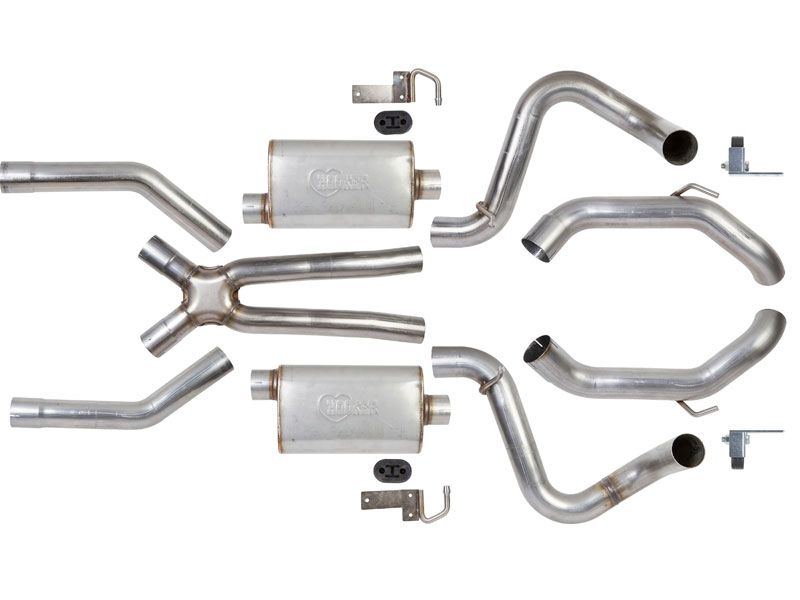Exhaust Components
FEBRUARY 19, 2016

The exhaust components system consists of many segments of pipes. They come in varied shapes and are designed to connect with one another and to fit specific parts on the bottom of your car (they can even be bent to go around other nearby parts). Each pipe is responsible for moving the exhaust gases to the back of the vehicle, but many segments are placed where they are for another reason, too. In other words, from the outside, it looks like a bunch of pipes running from the engine back to the bumper, but some pipes serve an additional purpose as the exhaust flows through it.
For example, the Y pipe (named for its Y-shape) might be installed so the end with two openings bolts up to two openings on the exhaust manifold, mixing the engine’s fumes as they move through the system. Or, when placed at the back end of the car, a Y pipe creates a dual exhaust system with a tailpipe on each side (for a sportier appearance). Air gap pipes are nested pipes to make a heat shield, giving insulation with an extra layer of airflow. Or, the tail pipe might be made with sturdier metal and a bigger opening, a look common in high-end cars.
Though it might seem inefficient to have a ton of pipes instead of just one, many of those segments serve extra purposes. After all, shaping one long, heavy, and expensive pipe to fit every contour for every vehicle is a lot harder than connecting small, angled segments together. It’s also easier to replace — how often just depends on the manufacturer, its materials, driving conditions and environmental factors. More importantly, it’s less expensive to replace one rusted-out segment of pipe or worn-out catalytic converter than it would be to install a whole new system!
While the pipes are the most visible part of the exhaust components system, it all really begins at the exhaust header — or exhaust manifold. The header looks like a series of heavy-duty cast metal tubes stuck together and it takes up the exhaust directly from the engine. Each one connects with one of the engine’s exhaust ports, forming a tight seal to keep exhaust from escaping. Next, the exhaust flows through all the different pipes and other components, making its way to the end of your car.
The gaskets between each pipe play a very important role, too, because it’s impossible to make a perfect seal between two metal pipes. Gaskets are sandwiched between each connection to keep the poisonous gases from leaking out. Heavy, heat-resistant materials give it enough flexibility to compress when the pipes are clamped tightly together. This forms the air-tight seal.

The muffler is another familiar but also key part of the exhaust components system. It usually looks like a round, oval chamber (usually at the back of the car). It is intricately designed, full of inner chambers and tubes filled with rock, wool, or synthetic fibers. This how the muffler is able to silence most of the engine’s noise while allowing the exhaust to continue flow smoothly. This exhaust components has to be somewhat resistant to damage, corrosion and excessive heat but does require replacement when damaged or worn out.
Catalytic converters (or “cat”) are like metal air filters for your exhaust system. Before the exhaust reaches the cat, it has super-toxic chemicals like carbon monoxide, hydrocarbons, and nitrogen oxide (these are the chemical levels tested during emissions tests). But the inside of a catalytic converter has a coating of metals like platinum, palladium, and rhodium. When the poisons come into contact with the cat, a chemical reaction changes the exhaust gases into a much less deadly form. As the exhaust passes through the cat, the level of chemicals are reduced enough to comply with government regulations.
The exhaust components system requires other basic pieces of hardware to pass the test. Flanges act like gaskets but they are made of metal and can be formed right onto the pipe. Various clamps and brackets hold the exhaust pieces together and help mount them to the vehicle, while exhaust hangers literally hang the pipes from the underside of the car. These have to be strong to keep the pipes in place but also flexible enough to handle the bumps of the road. Finally, there are the heat shields: insulated metal plates provide an extra barrier for pipes sitting close together or to the passenger areas.
More information on exhaust:
More Services we offer:
Loading ...
Missing business hours data / Error occurred while getting the data.
Our Location
Have Trouble Finding Us?
Loading ...
Missing nap lines data / Error occured while getting the data.
